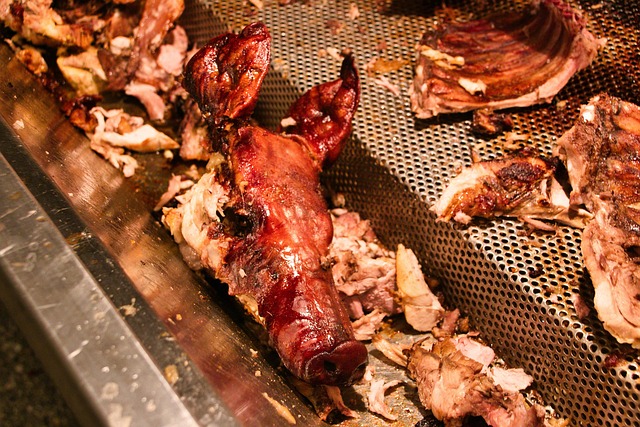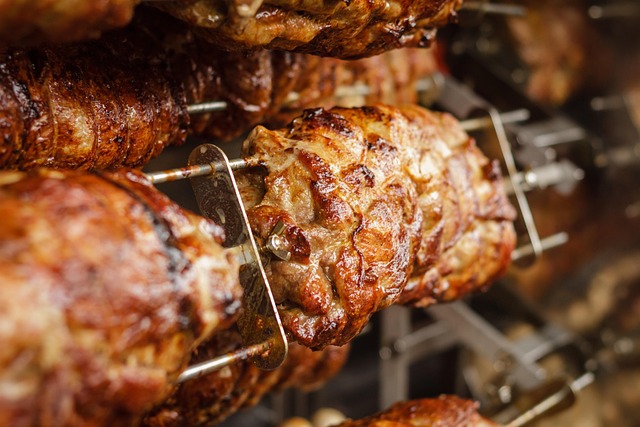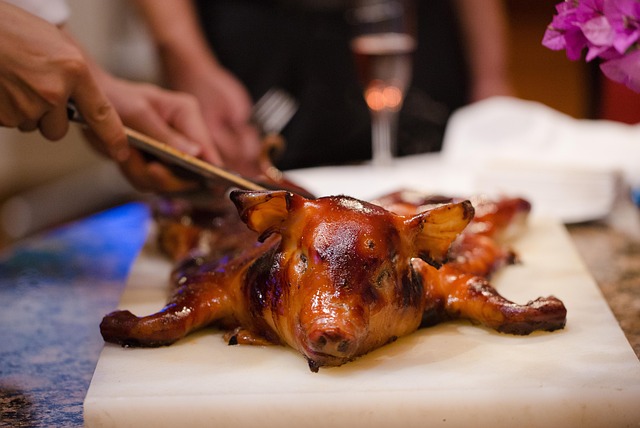The Icon of Balinese Feasting
Few dishes embody the fiery heart and spiritual depth of Bali like Babi Guling. Known to many as Balinese roasted suckling pig, this delicacy transcends the boundaries of mere food—it is an emblem of devotion, artistry, and community. Its glistening golden skin and aromatic spices speak a language of celebration, bringing together families, villages, and generations. In Bali, to serve Babi Guling is to serve joy itself.
The Origin of Babi Guling: A Sacred Culinary Heritage
From Ritual Offerings to Culinary Fame
Babi Guling was not born in kitchens but in temples. Traditionally prepared as an offering to the gods, this dish was central to sacred ceremonies honoring ancestors and deities. Over time, its sacred status permeated everyday life, transforming from a divine tribute into a national treasure—one that continues to grace both holy feasts and humble family gatherings.
How Balinese Hinduism Shaped the Tradition of Roasted Pork
Balinese Hinduism reveres the balance between humans, nature, and the divine. Food becomes the bridge that unites these realms. The roasting of a whole pig symbolizes wholeness, abundance, and respect for life’s cycles. Every Babi Guling offering is an act of harmony—an edible prayer wrapped in smoke and spice.
Cultural Significance in Balinese Life
The Role of Babi Guling in Ceremonial Banquets
From temple anniversaries to communal festivals, Babi Guling anchors the Balinese dining experience. Its preparation marks moments of gratitude and reverence, turning ordinary gatherings into sacred feasts.
Symbolism of Purity, Gratitude, and Prosperity
The golden hue of the roasted skin symbolizes purity and divine blessing, while the act of sharing the dish represents gratitude for abundance. Each slice served is a reminder of the island’s harmonious relationship with nature and spirit.
A Communal Dish that Unites Villages and Families
In Bali, Babi Guling is never made alone. It demands many hands, laughter, and stories shared around the fire. This collective process weaves bonds that go beyond kinship—it builds community.
The Traditional Preparation Ritual
Choosing the Perfect Pig: Age, Size, and Health
Tradition calls for a young pig, tender and pure. Farmers raise them with care, ensuring they are healthy and well-fed, for the spirit of the meal begins with respect for the animal itself.
Sacred Blessings Before the Roast Begins
Before fire touches flesh, priests or elders offer prayers, incense, and holy water. The ritual purifies both the animal and the people, inviting divine grace into the cooking process.
The Role of Village Elders and Culinary Masters
The task of roasting falls upon seasoned masters—those who understand fire as an ancient language. They oversee every turn, every crackle, ensuring perfection through patience and intuition.
The Spice Symphony: Bumbu Genep
Decoding the Complex Blend of Spices
At the heart of Babi Guling lies Bumbu Genep—a robust spice paste that embodies the island’s soul. It marries over a dozen ingredients into one harmonious medley.
The Aromatic Core: Turmeric, Coriander, and Lemongrass
Turmeric lends its golden hue, coriander offers warmth, and lemongrass infuses a citrusy brightness. Together, they create a perfume that envelops the senses and lingers in memory.
Local Secrets: Ingredients That Define Authentic Flavor
Some families add galangal, salam leaves, or even shrimp paste, guarding their recipes like heirlooms. Each variation whispers of lineage and geography—no two blends are ever truly alike.
The Art of Roasting Over Open Fire

Photo by Pixabay / Free to use under license.
Techniques of Skewering and Turning
The pig is skewered on a bamboo pole and slowly turned over smoldering embers. The rhythmic rotation—hour after hour—ensures even roasting and mesmerizing crispness.
Coconut Husk Flames and Their Signature Scent
Coconut husks burn with a mild, sweet smoke that perfumes the meat with tropical fragrance. The result is a flavor both primal and elegant.
The Golden Crisp: Achieving the Perfect Skin
The skin must crackle. It should shimmer like lacquer and shatter with the lightest bite—a delicate craft honed through generations.
Texture and Taste: A Dance of Contrasts
Crunchy Skin Meets Juicy Meat
Each serving offers a duet of sensations—the brittle crunch of skin and the tender succulence beneath. It’s a symphony of textures that commands reverence.
The Role of Spices in Layered Flavor Experience
The Bumbu Genep seeps deep into the meat, unveiling waves of heat, sweetness, and zest that unfold with each chew.
Why Every Bite Feels Ceremonial
Eating Babi Guling is an act of communion—between fire and flesh, between human and divine. It’s more than sustenance; it’s ritual in edible form.
Regional Variations Across Bali
Babi Guling Gianyar: The Benchmark of Tradition
Gianyar is often hailed as the heartland of Babi Guling. Here, recipes remain fiercely traditional, defined by rustic precision and reverence for ancestral methods.
Northern vs. Southern Styles: A Flavorful Divide
Northern Bali favors bolder spice infusions, while the south leans toward subtler, herbal tones. Each region crafts its identity through nuance.
Modern Twists from Urban Warungs
Urban chefs experiment with presentation—mini roasts, tacos, or sliders—yet the spirit of Babi Guling endures, even in reinvention.
The Accompaniments That Complete the Feast
Lawar: The Spicy Harmony of Minced Meat and Vegetables
Lawar—a textured mix of minced meat, coconut, and herbs—provides earthy contrast to the roasted richness. It is fiery, fragrant, and full of life.
Sambal Matah: Fiery Freshness in Every Spoon
Raw shallots, lemongrass, and chili ignite the palate with Sambal Matah, a condiment that awakens the senses.
Rice, Soup, and Crackers: The Traditional Ensemble
Served with steamed rice, a light broth, and crisp crackers, the ensemble balances heat, fat, and freshness—a culinary choreography perfected over centuries.
Serving Babi Guling the Balinese Way
How to Plate a Traditional Portion
Each portion carries a thoughtful balance—skin, meat, rice, and condiments—arranged in ritual harmony upon banana leaves.
The Ritual of Eating Together
Meals begin with shared gratitude. Families gather cross-legged, savoring each bite in communal silence or joyous laughter.
Etiquette and Respect During the Feast
One never wastes a morsel. To eat Babi Guling is to honor both the cooks and the spirits who blessed the meal.
Babi Guling in Balinese Ceremonies and Festivals
Weddings, Cremations, and Temple Offerings
Whether celebrating unions or farewells, Babi Guling accompanies every major passage of life. It sanctifies both beginnings and endings.
Culinary Devotion in Galungan and Kuningan
During Galungan and Kuningan, the dish becomes a sacred offering—its aroma weaving through villages as temples bloom with prayer.
The Spiritual Undertone Behind Every Serving
Beyond taste lies devotion. Each serving is imbued with gratitude, making Babi Guling not just a meal but a meditation.
Evolution in the Modern Culinary Scene

Photo by Pixabay / Free to use under license.
From Village Feasts to Tourist Favorites
Once reserved for rituals, Babi Guling now stars in bustling eateries, drawing travelers eager for authenticity wrapped in crisp skin.
Restaurants and Warungs Preserving Authenticity
From Ubud to Denpasar, humble warungs uphold tradition, turning ancient recipes into daily sustenance for locals and guests alike.
Chefs Reinventing Babi Guling for Contemporary Palates
Creative chefs introduce new forms—fusion bowls, artisanal platters—without diluting the soul of the dish. Innovation meets reverence.
Famous Spots to Savor Authentic Babi Guling
Ibu Oka in Ubud: A Legendary Destination
Synonymous with the dish itself, Babi Guling Ibu Oka has become a pilgrimage site for culinary seekers, its fame echoing worldwide.
Hidden Village Gems Off the Tourist Trail
Beyond the spotlight, remote villages offer renditions untouched by modernization—where recipes whisper of ancestors.
Local Recommendations from Balinese Elders
Ask any elder, and they’ll point you to a stall known only to locals—where flavor, not fame, defines greatness.
The Social Experience of Eating Babi Guling
Sharing, Celebration, and Storytelling Around the Table
Every gathering around Babi Guling becomes a living story—of heritage, laughter, and shared humanity.
How Food Strengthens Balinese Identity
The dish anchors Balinese culture, binding people through shared tradition and taste.
The Unspoken Rules of Enjoying Communal Meals
To eat together is to belong; to share Babi Guling is to affirm kinship and respect.
Sustainability and Ethical Considerations
Modern Approaches to Animal Welfare in Bali
As awareness grows, farmers emphasize humane practices, ensuring the tradition evolves ethically.
Balancing Tradition with Conscious Consumption
Balinese communities now explore ways to sustain both heritage and ecology—preserving cultural flavor while respecting nature’s balance.
How Local Farmers Support the Babi Guling Industry
Local agriculture thrives on demand for authentic ingredients, reinforcing the circular economy between food, land, and people.
Pairing Babi Guling with Beverages
Traditional Balinese Drinks to Complement the Flavors
Herbal infusions and es daluman (green grass jelly drink) cool the palate, harmonizing with the dish’s intensity.
Local Arak and Coconut Water: A Taste of the Island
Balinese arak adds warmth, while coconut water refreshes—two distinct yet perfect pairings for the fiery feast.
Modern Pairings for the Adventurous Foodie
Craft beers, tropical cocktails, or fine wine now join the table, blending old-world tradition with new-world flair.
The Secret Behind Its Universal Appeal
Why Tourists Fall in Love with Babi Guling
It’s not just taste—it’s the spectacle, the aroma, the ritual. Visitors leave with flavor memories that linger far beyond the island.
The Emotional Power of Flavor and Tradition
Each bite evokes a sense of belonging, even for strangers. The dish connects hearts through shared sensory experience.
How It Captures the Essence of Bali’s Spirit
Spiritual yet sensual, humble yet grand—Babi Guling mirrors Bali itself, a fusion of contrasts that somehow feels complete.
Home-Cooked Adaptations and Recipes
Simplified Versions for Modern Kitchens
Cooks around the world recreate Babi Guling using ovens or grills, adapting the art without losing its soul.
Techniques to Recreate Authentic Flavors at Home
To emulate its magic, one must honor the Bumbu Genep—its freshness, balance, and devotion to detail.
Preserving the Soul of the Dish Beyond Bali
Though far from its birthplace, the spirit of Babi Guling lives wherever care, patience, and gratitude meet in the kitchen.
Babi Guling in Popular Culture and Media
Its Presence in Travel Shows and Documentaries
From Anthony Bourdain to global food explorers, Babi Guling has graced screens worldwide as Bali’s culinary ambassador.
A Culinary Symbol of Bali’s Global Identity
The dish encapsulates the island’s mystique—ancient, spiritual, and irresistibly flavorful.
Stories and Legends Passed Through Generations
Every family has its tale—of the first roast, the best feast, the laughter shared around the fire. These stories keep the tradition alive.
Conclusion: The Eternal Flame of Balinese Heritage
More Than a Dish — A Celebration of Culture and Faith
Babi Guling is not just roasted pork—it is devotion made tangible, a living link between past and present.
The Lasting Legacy of Babi Guling in Modern Bali
As fires continue to crackle across Balinese villages, this timeless dish endures—its aroma rising with prayer, its flavor immortal in the soul of the island.




